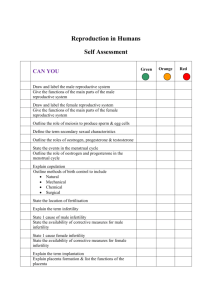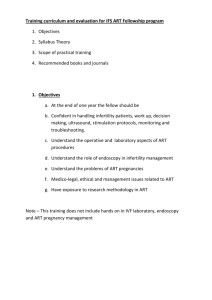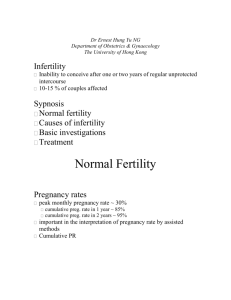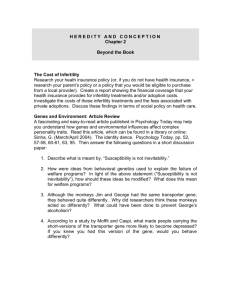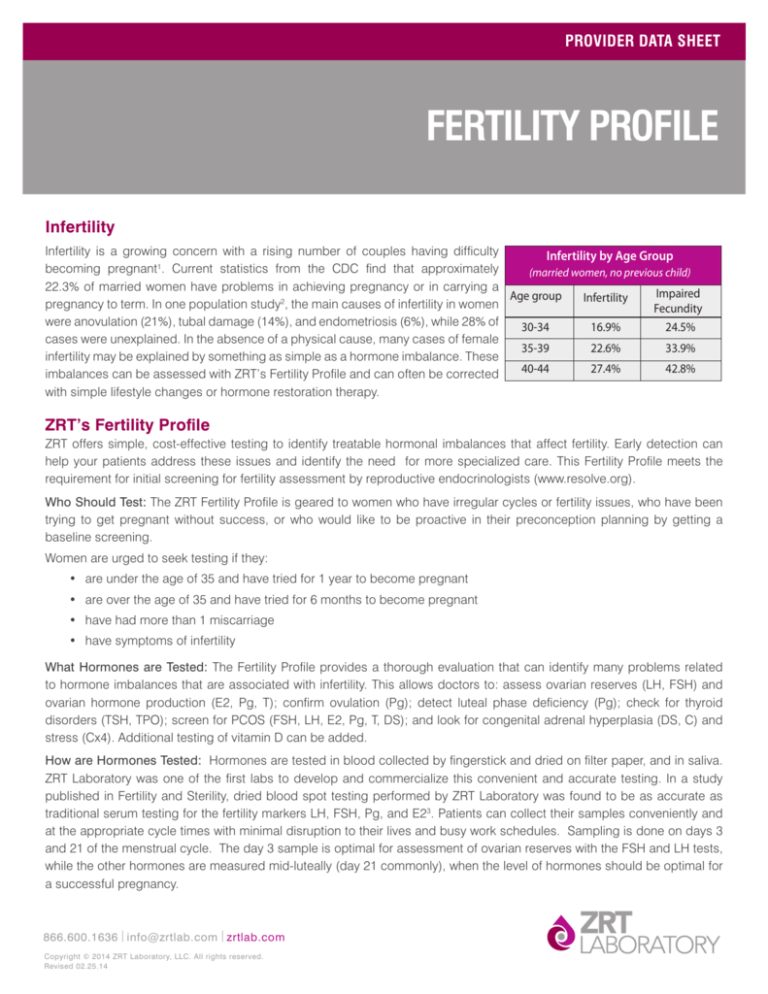
PROVIDER DATA SHEET
FERTILITY PROFILE
Infertility
Infertility is a growing concern with a rising number of couples having difficulty
Infertility by Age Group
becoming pregnant1. Current statistics from the CDC find that approximately
(married women, no previous child)
22.3% of married women have problems in achieving pregnancy or in carrying a
Impaired
Age group
Infertility
pregnancy to term. In one population study2, the main causes of infertility in women
Fecundity
were anovulation (21%), tubal damage (14%), and endometriosis (6%), while 28% of
30-34 16.9%
24.5%
cases were unexplained. In the absence of a physical cause, many cases of female
35-39 22.6%
33.9%
infertility may be explained by something as simple as a hormone imbalance. These
40-4427.4% 42.8%
imbalances can be assessed with ZRT’s Fertility Profile and can often be corrected
with simple lifestyle changes or hormone restoration therapy.
ZRT’s Fertility Profile
ZRT offers simple, cost-effective testing to identify treatable hormonal imbalances that affect fertility. Early detection can
help your patients address these issues and identify the need for more specialized care. This Fertility Profile meets the
requirement for initial screening for fertility assessment by reproductive endocrinologists (www.resolve.org).
Who Should Test: The ZRT Fertility Profile is geared to women who have irregular cycles or fertility issues, who have been
trying to get pregnant without success, or who would like to be proactive in their preconception planning by getting a
baseline screening.
Women are urged to seek testing if they:
• are under the age of 35 and have tried for 1 year to become pregnant
• are over the age of 35 and have tried for 6 months to become pregnant
• have had more than 1 miscarriage
• have symptoms of infertility
What Hormones are Tested: The Fertility Profile provides a thorough evaluation that can identify many problems related
to hormone imbalances that are associated with infertility. This allows doctors to: assess ovarian reserves (LH, FSH) and
ovarian hormone production (E2, Pg, T); confirm ovulation (Pg); detect luteal phase deficiency (Pg); check for thyroid
disorders (TSH, TPO); screen for PCOS (FSH, LH, E2, Pg, T, DS); and look for congenital adrenal hyperplasia (DS, C) and
stress (Cx4). Additional testing of vitamin D can be added.
How are Hormones Tested: Hormones are tested in blood collected by fingerstick and dried on filter paper, and in saliva.
ZRT Laboratory was one of the first labs to develop and commercialize this convenient and accurate testing. In a study
published in Fertility and Sterility, dried blood spot testing performed by ZRT Laboratory was found to be as accurate as
traditional serum testing for the fertility markers LH, FSH, Pg, and E23. Patients can collect their samples conveniently and
at the appropriate cycle times with minimal disruption to their lives and busy work schedules. Sampling is done on days 3
and 21 of the menstrual cycle. The day 3 sample is optimal for assessment of ovarian reserves with the FSH and LH tests,
while the other hormones are measured mid-luteally (day 21 commonly), when the level of hormones should be optimal for
a successful pregnancy.
866.600.1636 info@zrtlab.com zrtlab.com
Copyright © 2014 ZRT Laboratory, LLC. All rights reserved.
Revised 02.25.14
Saliva and Dried Blood Spot Testing.
Minimally-invasive home test kit.
The ZRT Test Report: ZRT’s comprehensive test report
is easy to interpret and includes not only the hormone
test numbers in an easy to read format, but also
your patient’s self reported symptoms, medications,
and hormones used, along with comprehensive
individualized comments explaining how their hormonal
imbalances could be causing infertility.
Hormone Changes During the
Menstrual Cycle
In women with infertility, some of the following hormonal
changes are seen:
High FSH level on Day 3, in the follicular phase,
reflects ovarian insufficiency and the beginnings of
menopause.
Low estradiol and progesterone on day 21 could
indicate ovarian insufficiency (low egg reserve).
Normal to high estradiol and low progesterone in
the luteal phase is a sign of no ovulation or of luteal
phase deficiency.
High testosterone and DHEA-S, as well as high LH
relative to FSH can indicate PCOS (polycystic ovarian
syndrome), which is linked to infertility in several
ways.
Follicular Phase
Luteal Phase
LH
Hormonal changes
in one cycle
Progesterone
Estrogen
FSH
Journey of the egg
Follicle
Egg
Ovulation
Corpus Luteum
Days of cycle 1 2 3 4 5 6 7 8 9 10 11 12 13 14 15 16 17 18 19 20 21 22 23 24 25 26 27 28
This illustration is an example of a 28-day-cycle. It shows the normal fluctuations
in estradiol, progesterone, LH, and FSH during a menstrual cycle, with
corresponding changes in the ovary.
Page 2
Hormonal Aspects of Infertility
Hormone-related causes of female infertility most often
involve the following five scenarios:
1. Ovarian Insufficiency
The average age of menopause is 51, with some women
having their last period in their forties and others later
in their fifties4. A cessation of ovulation prior to the age
of 40 is rare, and is usually referred to as premature
ovarian failure. Declining ovarian function is the main
reason for the age-related decline in female fertility. As
the number of available follicles starts to fall, estrogen
is still being produced but ovulation does not occur,
and progesterone levels are low in the absence of
a corpus luteum5,6. High FSH and LH levels on day
3 of the menstrual cycle typically confirm premature
ovarian failure and the onset of menopause. A typical
pattern of day 21 hormone levels indicating signs of
ovarian insufficiency would consist of low estradiol,
low progesterone, and low testosterone. LH, DHEA-S,
cortisol and thyroid hormones may or may not be
normal.
2. Luteal Phase Deficiency
In some patients who are infertile, ovulation may occur
normally but levels of progesterone are inadequate
following ovulation (luteal phase). This luteal
progesterone deficiency means that even if the egg is
fertilized, implantation either does not occur, or if it does,
the progesterone level is not high enough to sustain the
pregnancy. Luteal phase deficiency can be caused by
a number of problems, including endometriosis7 and
abnormal follicular development, but most commonly
it is a result of inadequate progesterone production
by the corpus luteum, which can result from excessive
stress (high or low cortisol) and/or thyroid imbalances.
A typical finding is low progesterone levels in the luteal
phase, usually with normal estradiol levels8.
3. Polycystic Ovarian Syndrome (PCOS)
PCOS is the most common endocrine disorder affecting
women of reproductive age and is closely associated
PROVIDER DATA SHEET
with insulin resistance, metabolic syndrome and future
risk of developing diabetes and cardiovascular disease9.
Among women presenting with infertility in one study,
PCOS was found to be present in 81% of women who
were anovulatory, in 50% of those with tubal disease,
and in 44% of those with unexplained infertility10.
Hormonally, it is characterized by low progesterone,
normal-to-high estradiol, high testosterone and normal
to high DHEA-S during the luteal phase; also, LH often
is elevated 2-3 times relative to FSH. Cortisol and
thyroid hormones may or may not be normal, although
women with PCOS have been found to have a three-fold
higher prevalence of autoimmune thyroiditis compared
to healthy women11.
a woman’s ability to conceive. Endometriosis is found
in more than 50% of women with unexplained infertility,
and the high cortisol and prolactin levels induced by
stress have been implicated in the development of this
condition17.
4. Hypometabolism/Thyroid Deficiency
Thyroid dysfunction, including subclinical
hypothyroidism (elevated TSH with normal fT3
and fT4 levels), has been implicated as a cause of
infertility. Thyroid hormone treatment can be a simple
solution to restore a regular menstrual pattern12.
In one study, levothyroxine treatment resulted in
pregnancy in 44% of infertile patients diagnosed with
subclinical hypothyroidism13. In patients with thyroid
dysfunction, the sex hormones (E2, Pg, T,) and adrenal
hormones (DS, C) may be normal in the presence
of hypothyroid symptoms and one or more of the
thyroid hormones out of balance. High TPO antibodies
indicate an autoimmune thyroid disease (e.g.,
Hashimoto’s Disease), which is associated with fertilityrelated problems. It is important to rule out thyroid
autoimmunity in women attempting to conceive because
of the increased risk of miscarriage14.
5. Stress
Stress raises the stress hormone cortisol, which can
severely affect a woman’s ability to conceive15, probably
because of its direct negative impact on the endocrine
glands ability to produce sex hormones (E2, Pg, T)
and thyroid hormones (see www.endotext.com16). The
diurnal cortisol variation measured in saliva samples
collected throughout the day is an index of the adrenal
glands’ ability to cope with stressors (emotional,
physical, dietary, chemical, pathogenic) that can impact
Innovating Hormone Testing
Page 3
References
13. Abalovich M, Mitelberg L, Allami C, Gutierrez S, Alcaraz G, Otero
1. Chandra A, Martinez GM, Mosher WD, Abma JC, Jones J.
in women with infertility. Gynecol Endocrinol. 2007; 23(5):279-83.
Data from the 2002 National Survey of Family Growth. National
14.Poppe K, Glinoer D, Tournaye H, Devroey P, Schiettecatte J,
Center for Health Statistics. Vital Health Stat 2005; 23(25).
P, Levalle O. Subclinical hypothyroidism and thyroid autoimmunity
Fertility, Family Planning, and Reproductive Health of US Women:
Available at: http://www.cdc.gov/nchs/data/series/sr_23/
sr23_025.pdf (accessed 10/5/2012).
2. Hull MG, Glazener CM, Kelly NJ, Conway DI, Foster PA, Hinton
RA, Coulson C, Lambert PA, Watt EM, Desai KM. Population
study of causes, treatment, and outcome of infertility. Br Med J
(Clin Res Ed). 1985;291(6510):1693-7.
3. Edelman A, Stouffer R, Zava DT, Jensen JT. A comparison of
blood spot vs. plasma analysis of gonadotropin and ovarian
steroid hormone levels in reproductive-age women. Fertil Steril.
2007;88(5):1404-7.
4. National Institute on Aging, US National Institutes of Health.
The Age Page.
Available at: http://www.nia.nih.gov/health/
publication/menopause (accessed 10/5/2012).
5. Ahmed Ebbiary NA, Lenton EA, Salt C, Ward AM, Cooke ID.
The significance of elevated basal follicle stimulating hormone
Haentjens P, Velkeniers B. Thyroid autoimmunity and female
infertility. Verh K Acad Geneeskd Belg. 2006;68(5-6):357-77.
15.Nakamura K, Sheps S, Clara Arck P. Stress and reproductive
failure: past notions, present insights and future directions. J
Assist Reprod Genet. 2008;25(2-3):47-62.
16.Tsigos C, Kyrou I, Chrousos G. Stress, endocrine physiology
and pathophysiology.
Available at: http://www.endotext.com/
adrenal/adrenal8/adrenalframe8.htm (accessed 10/5/2012).
17.Lima AP, Moura MD, Rosa e Silva AA. Prolactin and cortisol
levels in women with endometriosis. Braz J Med Biol Res.
2006;39(8):1121-7.
Useful websites:
International Council on Infertility Information Dissemination:
www.inciid.org
in regularly menstruating infertile women. Hum Reprod.
American Society for Reproductive Medicine: www.asrm.org
1994;9(2):245-52.
American Academy of Fertility Care Professionals: www.aafcp.org
6. Santoro N, Brown JR, Adel T, Skurnick JH. Characterization of
reproductive hormonal dynamics in the perimenopause. J Clin
NaProTechnology (Natural Procreative Technology):
www.naprotechnology.com
Endocrinol Metab. 1996;81(4):1495-501.
7. Cunha-Filho JS, Gross JL, Bastos de Souza CA, Lemos NA,
Giugliani C, Freitas F, Passos EP. Physiopathological aspects
of corpus luteum defect in infertile patients with mild/minimal
endometriosis. J Assist Reprod Genet. 2003;20(3):117-21.
8. Soules MR, McLachlan RI, Ek M, Dahl KD, Cohen NL, Bremner
WJ. Luteal phase deficiency: characterization of reproductive
hormones over the menstrual cycle. J Clin Endocrinol Metab.
1989;69(4):804-12.
9. Kousta E, Tolis G, Franks S. Polycystic ovary syndrome.
Revised diagnostic criteria and long-term health consequences.
Hormones (Athens). 2005;4(3):133-47.
10.Kousta E, White DM, Cela E, McCarthy MI, Franks S. The
prevalence of polycystic ovaries in women with infertility. Hum
Reprod. 1999;14(11):2720-3.
11. Janssen OE, Mehlmauer N, Hahn S, Offner AH, Gärtner R. High
prevalence of autoimmune thyroiditis in patients with polycystic
ovary syndrome. Eur J Endocrinol. 2004;150(3):363-9.
12.Trokoudes KM, Skordis N, Picolos MK. Infertility and thyroid
disorders. Curr Opin Obstet Gynecol. 2006;18(4):446-51.
866.600.1636 info@zrtlab.com
zrtlab.com
Innovating Hormone Testing
Page 4

